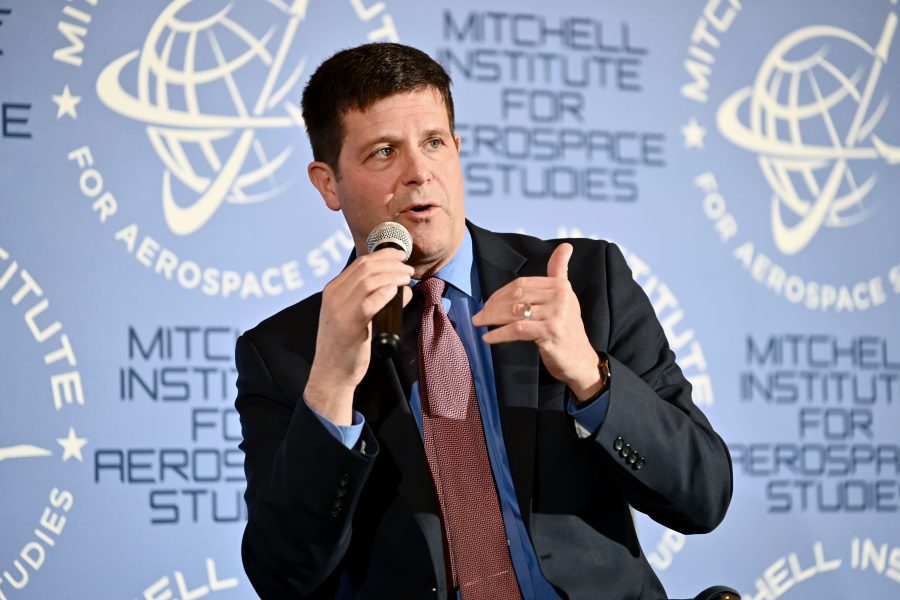The Department of Defense wants to make commercial capabilities “integral” to its space architectures in a way that goes beyond how the Pentagon typically relies on contractors, with particular focus on more than a half dozen mission areas.
What’s more, the department made clear in its first-ever Commercial Space Integration Strategy released April 2 that it is prepared to protect those commercial assets in a conflict, a key signal to reassure industry.
The 16-page strategy, formulated by assistant secretary of defense for space policy John F. Plumb, reaffirms what Pentagon space leaders have been saying for months now: commercial satellites, ground control stations, networks, and operators will play an outsized role in the future of military space, especially as more and more companies join in and expand their operations in the booming sector.
“Deeper integration of commercial space solutions represents a conceptual shift away from legacy practices,” the strategy states. “ … Given the expansion of the commercial space sector and the proliferation of space capabilities, the Department will benefit by making commercial solutions integral—and not just supplementary—to national security space architectures.”
The strategy notes that the Pentagon and commercial companies already collaborate on programs like the Civil Reserve Air Fleet and the Voluntary Intermodal Sealift Agreement. But the department wants to go even further in space to “ensure access to commercial solutions across the spectrum of conflict,” not just during crisis.
There are multiple reasons for that, Mitchell Institute senior fellow and retired Space Force Col. Charles Galbreath suggested: the explosion of commercial interest in space, the unique characteristics of the space domain, and the small size of the Space Force.
Broadly, the Pentagon is open to working with commercial companies on any of the 13 defined mission areas laid out in the strategy. But because commercial space is inherently focused on technologies that are commercially viable outside of the government and some missions are inherent to the military, certain mission areas will be prioritized.
Most of those are “hybrid,” which Plumb told reporters means they will likely wind up being “50/50, some government and some commercial, pretty much even stevens.”
Hybrid mission areas include:
- Intelligence, surveillance, and reconnaissance (ISR)
- Space domain awareness
- Environmental monitoring
- Spacecraft operations
- Satellite communications
- Cyberspace
“It is good to see space domain awareness explicitly in the hybrid category,” Galbreath said. “In the near future, we could see commercial products calling out hostile or irresponsible behavior in the same way we saw commercial ISR monitor Russia’s invasion of Ukraine.”
The inclusion of spacecraft operations in the hybrid category lends more momentum to the idea the Space Force is exploring of relying on contractors to help fly its satellites. Chief of Space Operations Gen. B. Chance Saltzman recently said the service was considering the possibility.
One area is identified as primarily commercial: Space Access, Mobility, and Logistics. While there is growing interest and excitement around the possibility of in-orbit servicing of satellites, to include refueling, Plumb noted that for now, SAML largely refers to launch.
Given the tight bonds the Pentagon wants to build with commercial industry, the strategy lists four priorities it will pursue:
- Ensure access to commercial solutions across the spectrum of conflict
- Achieve integration prior to crisis
- Establish the security conditions to integrate commercial space solutions, which means protecting commercial space assets under threat
- Support the development of new commercial space solutions for use by the joint force
Galbreath praised the strategy for incorporating commercial space prior to conflict.
“As the saying goes, we go to war with the force we have,” he said, “so integrating the commercial providers into the mix early so we can incorporate them in wargames and exercises is essential to ensuring we can rely on them in conflict and work through any issues well in advance of an actual crises or conflict.”
The third priority will likely draw attention from companies who are worried their satellites will become targets if they contribute to government missions. The strategy states that “in appropriate circumstances, the use of military force to protect and defend commercial assets could be directed.”
It’s a question that military space leaders have been asked for months now, and while Saltzman has hinted the U.S. would protect commercial assets from attack much as the Navy protects shipping lanes, the strategy marks a definite, if open-ended, signal that the Pentagon is prepared to do so.
“The clear statement … is powerful. It still leaves open the range of military options including ground, maritime, air, cyber, and space,” Galbreath said.
In addition to military actions, the strategy notes three other ways it wants to protect commercial companies that collaborate with the Pentagon: establishing norms of behavior in space, sharing threat information, and financial compensation.
On the last front, the Pentagon pledges in the strategy to explore the possibility of U.S. government-provided war risk insurance for space like it does in the air and maritime domains.
Plumb declined to say when such insurance might be available, but he noted other kinds of financial protection that might be available to companies in case their satellites are targeted.
The release of the strategy likely signals the imminent release of the Space Force’s own commercial space strategy, which has been in the works for months. Saltzman said last week at the Mitchell Institute Spacepower Security Forum that he hoped to have the strategy released by the annual Space Symposium, which starts April 8.
“It is a little bit more focused on service-specific, acquisition-specific,” Plumb said. “And frankly, how he as a service chief wants to see his military service.”

